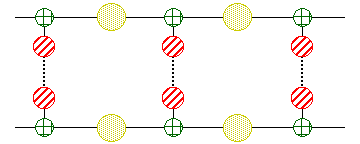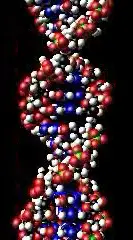Nucleic acid
A nucleic acid is a complex, high-molecular-weight macromolecule composed of nucleotide chains whose sequence of bases conveys genetic information. Nucleic acids are found in all living cells and in viruses, and the flow of genetic information is essentially the same in all organisms.
The most common nucleic acids are deoxyribonucleic acid (DNA) and ribonucleic acid (RNA). The main role of DNA in the cell is the long-term storage of information. It is often compared to a blueprint, since it contains the instructions to construct other components of the cell, such as proteins and RNA molecules. The DNA segments that carry genetic information are called genes, but other DNA sequences have structural purposes, or are involved in regulating the expression of genetic information. RNA serves as the template for translation of genes into proteins, transferring amino acids to the ribosome to form proteins, and also translating the transcript into proteins. While both types of nucleic acids are involved in the storage and transmission of genetic information, some RNA molecules (called ribozymes) are also involved in the catalysis of biochemical reactions.
DNA is a major component of the chromosomes in the nuclei of eukaryotic cells and can also be found in other cellular components (e.g., mitochondria). The cytoplasms of prokaryotes (which lack a nucleus) also contain DNA, andlRNA is found in both the nucleus and cytoplasm of many cells.
significance
The chemical structure of nucleic acids
Components

Nucleic acids are polymers of repeating units (called monomers). Specifically, they consist of long chains of nucleotide monomers connected by covalent chemical bonds. RNA molecules may contain as few as 75 nucleotides to more than 5000 nucleotides, while a DNA molecule may be composed of more than 1,000,000 nucleotide units.
A nucleotide is a chemical compound with three components: a nitrogen-containing base, a pentose (five-carbon) sugar, and one or more phosphate groups. The nitrogen-containing base of a nucleotide (also called the nucleobase) is typically a derivative of either purine or pyrimidine. The most common bases in nucleotides are the purines adenine and guanine and the pyrimidines cytosine and thymine (or uracil in RNA).
The sugar component is either deoxyribose or ribose. (“Deoxy” simply indicates that the sugar lacks an oxygen atom present in ribose, the parent compound.)
There are two major compositional differences between RNA and DNA:
- The sugar units in RNA molecules are riboses, while DNA is built of nucleotides with a deoxyribose sugar.
- One of the four major nucleobases in RNA is uracil (U) instead of thymine (T).
Organization
To build the nucleic acid polymer out of individual nucleotides, phosphodiester bonds are formed between the phosphate residue of one nucleotide and one of two possible carbons on the sugar molecule of an adjacent nucleotide. These sugar-phosphate interactions play a primarily structural role, forming what is sometimes referred to as the "backbone" of the nucleic acid.
Nucleic acids may organize into single-stranded or double-stranded molecules. The DNA of many chromosomes and DNA-containing viruses forms long, unbranched, double-helical threads, in which two strands of DNA coil around a common axis. The strands run in opposite directions, and are held together by hydrogen bonds between pairs of bases from each strand. The base adenine is always paired with thymine, and guanine with cytosine (i.e., a purine pairs with a pyrimidine). The stability created by the hydrogen-bonding between these complementary base pairs makes DNA a sturdy form of genetic storage.
In contrast, the DNA of many viruses and the DNA found in mitochondria are circular; in some cases, they also twist into a supercoiled form. RNA is usually single-stranded, but it may contain double-helical regions where a given strand has folden back on itself.
Nucleic acids store and transmit genetic information
Nucleic acids are primarily biology's means of storing and transmitting genetic information, though RNA is also capable of acting as an enzyme.
DNA
DNA contains the genetic information that allows living things to function, grow and reproduce. This information is held in the sequence of pieces of DNA called genes. Genetic information in genes is transmitted through complementary base pairing. For example, when a cell uses the information in a gene, the DNA sequence is copied into a complementary RNA sequence in a process called transcription. Usually, this RNA copy is then used to make a matching protein sequence in a process called translation. Alternatively, a cell may simply copy its genetic information in a process called DNA replication. The details of these functions are covered in other articles; here, we focus on the interactions that happen in these processes between DNA and other molecules.
Transcription and translation
The nucleobases (which are the variable part of the DNA molecule) carry genetic information. Within a gene, the sequence of nucleotides along a DNA strand defines a messenger RNA sequence, which in turn defines a protein. The relationship between the nucleotide sequence and the amino-acid sequence of the protein is determined by simple cellular rules of translation, known collectively as the genetic code. The genetic code is the relation between the sequence of bases in DNA (or its RNA transcript) and the sequence of amino acids in proteins. Amino acids are coded by groups of three bases (called codons) starting from a fixed point (e.g. ACT, CAG, TTT). These codons can then be translated with messenger RNA and then transfer RNA from the chemical language of nucleic acids to that of amino acids, with each codon corresponding to a particular amino acid.
Replication
Cell division is essential for an organism to grow, but when a cell divides it must replicate the DNA in its genome so that the two daughter cells have the same genetic information as their parent. The double-stranded structure of DNA provides a simple mechanism for DNA replication. Here, the two strands are separated and then each strand's complementary DNA sequence is recreated by an enzyme called DNA polymerase. This enzyme makes the complementary strand by finding the correct base through complementary base pairing, and bonding it onto the original strand. All such DNA polymerases extend a DNA strand in a 5 prime to 3 prime direction.[1] In this way, the base on the old strand dictates which base appears on the new strand, and the cell ends up with an perfect copy of its DNA.
RNA
in contrast to DNA, RNA has a greater variety of possible structures and properties due to the diversity of roles it performs in the cell.
- Messenger RNA (mRNA) is RNA that carries information from DNA to the ribosome sites of protein synthesis in the cell. Once mRNA has been transcribed from DNA, it is exported from the nucleus into the cytoplasm (in eukaryotes mRNA is "processed" before being exported), where it is bound to ribosomes and translated into protein. After a certain amount of time the message degrades into its component nucleotides, usually with the assistance of RNA polymerases.
- Transfer RNA (tRNA) is a small RNA chain of about 74-93 nucleotides that transfers a specific amino acid to a growing polypeptide chain at the ribosomal site of protein synthesis during translation. It has sites for amino-acid attachment and an anticodon region for codon recognition that binds to a specific sequence on the messenger RNA chain through hydrogen bonding. It is a type of non-coding RNA.
- Ribosomal RNA (rRNA) is a component of the ribosomes, the protein synthetic factories in the cell. Eukaryotic ribosomes contain four different rRNA molecules: 18S, 5.8S, 28S, and 5S rRNA. Three of the rRNA molecules are synthesized in the nucleolus, and one is synthesized elsewhere. rRNA molecules are extremely abundant and make up at least 80% of the RNA molecules found in a typical eukaryotic cell.
In the cytoplasm, ribsomal RNA and protein combine to form a nucleoprotein called a ribosome. The ribosome binds mRNA and carries out protein synthesis. Several ribosomes may be attached to a single mRNA at any time.
Some RNA molecules function as enzymes
A ribozyme (from ribonucleic acid enzyme, also called RNA enzyme or catalytic RNA) is an RNA molecule that catalyzes a chemical reaction. Many natural ribozymes catalyze either their own cleavage or the cleavage of other RNAs, but they have also been found to catalyze the aminotransferase activity of the ribosome. Although RNA contains only four bases, in comparison to the twenty amino acids commonly found in proteins, some RNAs are still able to catalyse chemical reactions. These include cutting and ligating other RNA molecules and also the catalysis of peptide bond formation in the ribosome
ReferencesISBN links support NWE through referral fees
- Stryer, Lubert. 1995. Biochemistry, 4th edition. New York, N.Y.: W.H. Freeman.
External links
Template:ChemicalSources
| Nucleic acids edit |
|---|
| Nucleobases: Adenine - Thymine - Uracil - Guanine - Cytosine - Purine - Pyrimidine |
| Nucleosides: Adenosine - Uridine - Guanosine - Cytidine - Deoxyadenosine - Thymidine - Deoxyguanosine - Deoxycytidine |
| Nucleotides: AMP - UMP - GMP - CMP - ADP - UDP - GDP - CDP - ATP - UTP - GTP - CTP - cAMP - cGMP |
| Deoxynucleotides: dAMP - dTMP - dUMP - dGMP - dCMP - dADP - dTDP - dUDP - dGDP - dCDP - dATP - dTTP - dUTP - dGTP - dCTP |
| Nucleic acids: DNA - RNA - LNA - PNA - mRNA - ncRNA - miRNA - rRNA - siRNA - tRNA - mtDNA - Oligonucleotide |
Credits
New World Encyclopedia writers and editors rewrote and completed the Wikipedia article in accordance with New World Encyclopedia standards. This article abides by terms of the Creative Commons CC-by-sa 3.0 License (CC-by-sa), which may be used and disseminated with proper attribution. Credit is due under the terms of this license that can reference both the New World Encyclopedia contributors and the selfless volunteer contributors of the Wikimedia Foundation. To cite this article click here for a list of acceptable citing formats.The history of earlier contributions by wikipedians is accessible to researchers here:
The history of this article since it was imported to New World Encyclopedia:
Note: Some restrictions may apply to use of individual images which are separately licensed.
- ↑ Albà M (2001). Replicative DNA polymerases. Genome Biol 2 (1): REVIEWS3002. PMID 11178285.

